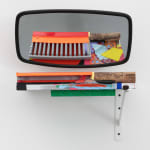![Jessica Stockholder, Landscape & Truck Mirror [JS 845], 2020](https://artlogic-res.cloudinary.com/w_1600,h_1600,c_limit,f_auto,fl_lossy,q_auto/artlogicstorage/boeskygallery/images/view/eae019fe4b18b803aa10ad35c980a8bdj/marianneboeskygallery-jessica-stockholder-landscape-truck-mirror-js-845-2020.jpg)
![Jessica Stockholder, Landscape & Truck Mirror [JS 845], 2020](https://artlogic-res.cloudinary.com/w_1600,h_1600,c_limit,f_auto,fl_lossy,q_auto/artlogicstorage/boeskygallery/images/view/10a9a2b523dbe27290adcfe3c281e92fj/marianneboeskygallery-jessica-stockholder-landscape-truck-mirror-js-845-2020.jpg)
Jessica Stockholder
Landscape & Truck Mirror [JS 845], 2020
Glass shelf, steel frame, metal bracket, truck mirror, oil paint, acrylic paint, wool felt, rubber pad, plastic mesh, fluorescent plastic reflector, plastic grill, branch, hardware, silicone, painted styrofoam, glue and sculpey
19 x 16 1/2 x 10 1/2 inches
48.3 x 41.9 x 26.7 cm
48.3 x 41.9 x 26.7 cm
JSH.21032
© Artist
Stockholder’s practice, spanning four-decades, has consistently prodded the dialogue between painting and sculpture. Her work explores the relationship between the pictorial experience of the surface and the dimensionality of physical...
Stockholder’s practice, spanning four-decades, has consistently prodded the dialogue between painting
and sculpture. Her work explores the relationship between the pictorial experience of the surface and
the dimensionality of physical objects. These works enable our focus to oscillate from our experience of
objects in the round to the complexity that is generated by their surfaces. Tending to the intersection of
these different modes of apprehension, and ways of codifying experience, presents a compelling
impression of existence. Incorporating quotidian goods, Jessica Stockholder incorporates their aesthetic, and formal qualities,
into works that are greater than the sum of their parts. She also welcomes the resonance of the ‘things’
she uses from the world with function, design, and issues of class and taste, even while deliberately
disassociating them from their expected use. She has said, “on some level, I can make work out of
anything.” Stockholder is not in search of the perfect object or material; rather, she is most concerned
with how the works that she authors are in dialogue with the world around her. The assemblages feel
deeply intentional, each component carrying great significance and entropy, and fluidly existing in a
space that exalts the promiscuity of meaning and material. In the present work, Stockholder makes use of a mirror, angled so as to enable views of the underside and topside of the shelflike structure below, to be seen simultaneously on the single plane of the mirror. Stockholder plays with the reflective quality of a commercial mirror, angling it just enough for the view
to see the sculpture but also themselves. Despite the industrial intention of the material, the mirror
brings intimacy to the work.
and sculpture. Her work explores the relationship between the pictorial experience of the surface and
the dimensionality of physical objects. These works enable our focus to oscillate from our experience of
objects in the round to the complexity that is generated by their surfaces. Tending to the intersection of
these different modes of apprehension, and ways of codifying experience, presents a compelling
impression of existence. Incorporating quotidian goods, Jessica Stockholder incorporates their aesthetic, and formal qualities,
into works that are greater than the sum of their parts. She also welcomes the resonance of the ‘things’
she uses from the world with function, design, and issues of class and taste, even while deliberately
disassociating them from their expected use. She has said, “on some level, I can make work out of
anything.” Stockholder is not in search of the perfect object or material; rather, she is most concerned
with how the works that she authors are in dialogue with the world around her. The assemblages feel
deeply intentional, each component carrying great significance and entropy, and fluidly existing in a
space that exalts the promiscuity of meaning and material. In the present work, Stockholder makes use of a mirror, angled so as to enable views of the underside and topside of the shelflike structure below, to be seen simultaneously on the single plane of the mirror. Stockholder plays with the reflective quality of a commercial mirror, angling it just enough for the view
to see the sculpture but also themselves. Despite the industrial intention of the material, the mirror
brings intimacy to the work.



